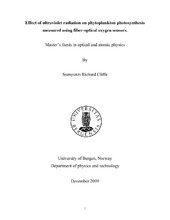| dc.description.abstract | Since the discovery of the Antarctic ozone hole' many studies have been conducted to determine the effect of UV radiation on photosynthetic rate of phytoplankton. It is accepted now that increased levels of UV radiation are stressful for some phytoplankton. In this thesis have developed and implemented an experimental system (a photoinbitron) for measuring photosynthesis of phytoplankton suspensions during controlled, quantified exposures to a broad range of UV radiation and PAR treatments. We have also carried out experiments to evaluate the effects of UVR on phytoplankton photosynthesis. The results from this experiment presented two selected algae species from different classes, Haematococcus pluvialis and Phaeodactylum tricornutum which differ in many ways, especially in regard to their habitats. The impact of UVR was assessed by exposing the samples to a constant irradiance of UVA and PAR but with varying irradiances of UVB exposure which ranged from 20% to 100% of the maximum available intensity. The radiation was divided into five different radiation treatments using cut off filters (280, 295, 305 and 395) so that samples received radiation at five different intervals within the UVR in addition to PAR, and only PAR respectively. For irradiation treatment (PAR) without UVR, photosynthesis in all samples tested was not affected during the course of 20 min of exposure. When the samples were exposed to full irradiance spectra, photosynthesis was inhibited to a variable degree in all samples of the two algae species tested. Strong inhibition was observed in algae samples when the UVB levels were at 100% and least inhibition when levels of UVB exposure were at 20%. Of the two selected species tested, the most sensitive specie was Phaeodactylum tricornutum and Haematococcus pluvialis was the least sensitive to UVB irradiance. This may probably be related to adaptation through the accumulation of UVB screening compounds, to high UVB levels. Most of the observed variability in all the samples tested was due to change in UVB levels. Photosynthetic oxygen evolution performances in response to UVB were measured using oxygen fiber optical micro sensors which are based on oxygen dependent dynamic fluorescence quenching. | en_US |
